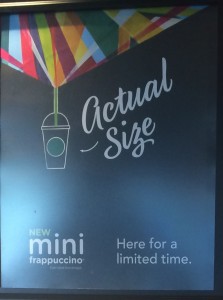Below is my latest blog post for Huffington Post, Starbucks to mini size it!
You can also read it HERE.
As a portion-size advocate, I was glad to hear about Starbucks plan to unveil the “mini” 10 oz. Frappuccino sugar-sweetened coffee drink, two ounces smaller than the “Tall” (also the smallest size sold by the coffee chain).
The new “mini” size would be considered a “regular” size by the 1970s standards, a time before the era of supersize portions and oversize people. But in today’s food environment of Venti, Trenta, and Big Gulp size drinks, it seems like progress for the food industry.
Americans rarely want less of anything. We are a nation attracted to bargains and deals, and that certainly includes big portions of foods and drinks. And the food industry has been wonderful at selling us cheap food in mega sizes.
Just a few years ago, back in 2011, Starbucks introduced the “trenta” size iced coffee, a 30+ oz. size, still available today.
Why the introduction of a “mini” size now?
Starbucks said it was responding to customer requests for the smaller Frappuccino size. According to Business Cheat Sheet, “Katie Seawell, senior vice president of category brand management at Starbucks, told the AP the mini Frappuccino helped lift overall store sales in the regions where it was tested last year… Seawell added it attracted new customers and got existing customers to come back more frequently.”
Are consumers interested in health or are they hoping that a smaller size would cost them less? It looks like the former. According to the Associated Press (AP), the “mini” size will only cost 20-30 cents less than the Tall size.
But the smaller size will contain fewer calories than larger sizes, and therefore, will be good for the waistline.
According to AP, “For the regular coffee with no whipped cream, Starbucks says it’ll have 120 calories and 24 grams of sugar. That’s compared with 180 calories and 36 grams of sugar for a small (tall) and 240 calories and 50 grams of sugar for a medium (grande). A large (venti) Frappuccino has 350 calories and 69 grams of sugar.”
Seems like progress. I hope this trend continues.
The soda industry has aggressively responded to anti-soda activists (including me) by selling smaller 7.5 oz. cans of sodas. Smaller sodas are lower in sugar than the larger sizes, better for health, and certainly selling points for parents. (Never mind that the 7.5 oz can costs more than the 12 oz. can, and that kids should be drinking water instead of soda.)
It is my hope moving forward, that as a food manufacturer introduces a new smaller size, it gets rid of the largest size. That would be the best way to reshape societal norms about how much food and drink constitutes a reasonable portion.
Mike Bloomberg, former mayor of New York City, tried this by attempting to cap the size of sugary drinks sold in chain eating establishments to 16 oz. But his attempt failed. (Not surprisingly, the soda industry sued the city and court system called the portion cap an overreach of power.)
In my opinion piece for the NY Daily News, I supported Bloomberg’s efforts.
As I wrote,
“Bloomberg is not banning the sale of soda. Nor is he telling consumers that they can’t drink soda. Rather, he is calling attention to how much is a reasonable amount to drink at a time. Sixteen ounces is certainly more than reasonable — a full pint of sugar water. Instead of viewing this as a ban, let’s see it as an attempt to reset the norm for how much soda truly constitutes an appropriate portion.
And while one policy alone will not solve the problem, encouraging New Yorkers to watch what they consume is a much-needed step toward reversing the obesity epidemic. It is time to return to the more reasonable sizes of the past, when obesity rates were lower.”
Perhaps the former mayor was ahead of his time. Maybe now. It’s not too late.
Let us remember, when it comes to portion sizes and attempts to lose weight, size does matter.
Kudos to Starbucks. And I am hoping that the coffee chain considers dropping its large venti size Frappuccino in the not so distant future.
Follow Dr. Lisa Young on Twitter: www.twitter.com/drlisayoung




